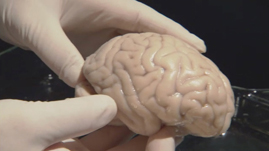Teachers' Domain - Digital Media for the Classroom and Professional Development
User: Preview

Source: The Human Spark: "Brain Matters"




Major funding for The Human Spark is provided by the National Science Foundation, and by the Alfred P. Sloan Foundation. Additional funding is provided by the John Templeton Foundation, the Cheryl and Philip Milstein Family, and The Winston Foundation.
ALAN ALDA (NARRATION) Here’s a human brain, happily not mine, wrinkled and beige and dense and unassuming as it’s laid out on a bench at Emory University in Atlanta. They have a lot of brains here, preserved for research. This is from a chimpanzee – a little less wrinkled, and perhaps a third the size of the human brain, but otherwise not looking much different. Next in line is the brain from a monkey, even smaller but still familiar in shape. Finally the brain of a rat. Until very recently, science knew much more about the brains of the rat and monkey than those of the chimp or ourselves.
ALAN ALDA I’m now going to pick up the human brain.
ALAN ALDA (NARRATION) The single most notable thing about the human brain is its sheer size, much bigger in proportion to our bodies than that of almost any other creature – three or four times bigger than a chimp’s brain, for instance, which itself is unusually large.
The question of why our brains became so big is one that will drive much of the agenda for the rest of our search for the Human Spark. It’s a question that has long fascinated Oxford University’s Robin Dunbar.
ROBIN DUNBAR The traditional story has always been making tools and hunting, you know, this kind of technological expertise. I don’t think that’s right. I think it’s social skills, and this goes back to the general view as to why primates have bigger brains than all other species of animals. It’s to do with the complexity of the societies they live in. So they’re just socially much smarter if you like. Their whole evolutionary strategy has been to solve problems socially, communally. So in effect, they live in a kind of implicit social contract, if you like. They kind of collaborate with each other in order to solve the problems of everyday life and death. So the logic of the argument is, you’ve got an ecological problem out there you have to solve. You solve that by having a group. In order to live in a big group you have to have a brain with sufficient computing power to handle the relationships.
ALAN ALDA (NARRATION) A chimpanzee has to keep track of about 50 individuals – the typical group size in the wild. Robin Dunbar argues that humans, by contrast, can comfortably handle about 150 relationships.
ROBIN DUNBAR It’s very roughly the number of people you know as persons, as individuals. You know enough about them that you know where they fit into your social world, you know where you fit into their social world, you know that if you ask them a favor they would kind of grumble but they would probably say OK.
ALAN ALDA (NARRATION) Robin notes that the three-fold increase in group size ¬– from 50 in chimps to 150 in humans – fits nicely with the three times bigger brains we humans possess.
 Loading Standards
Loading Standards